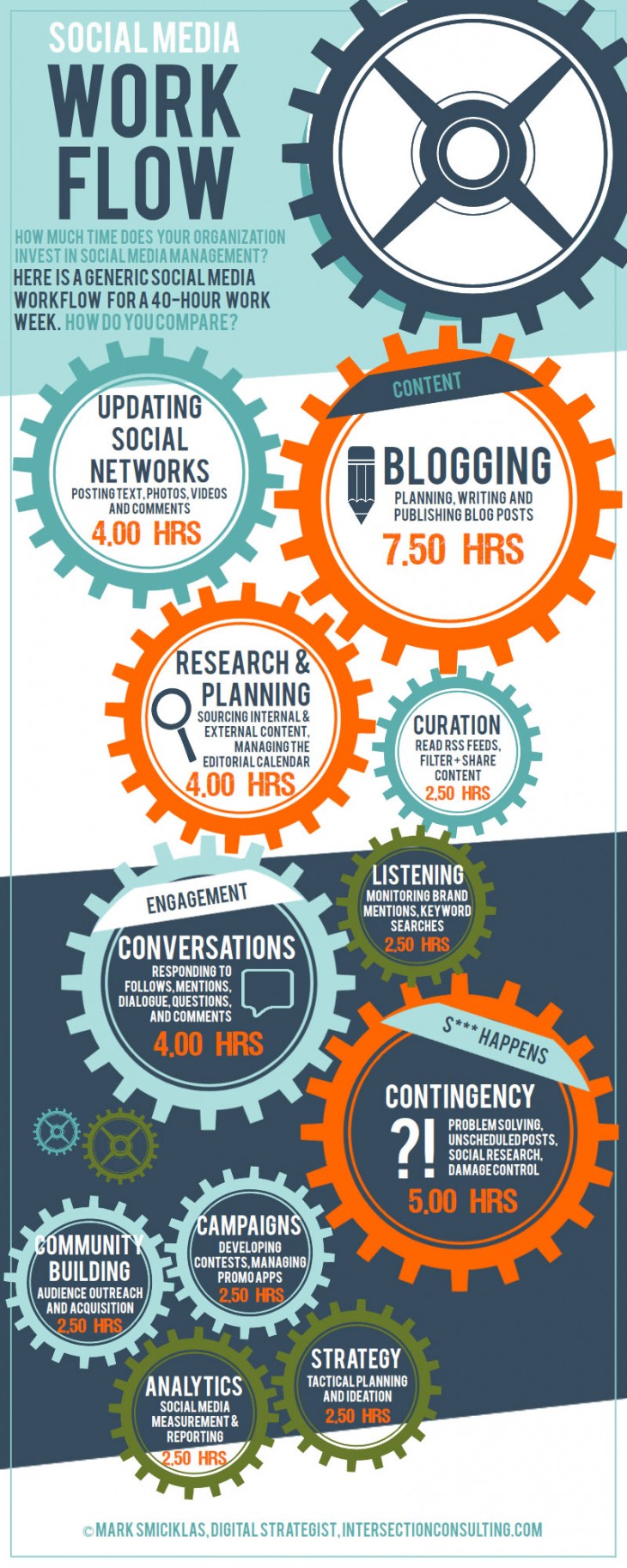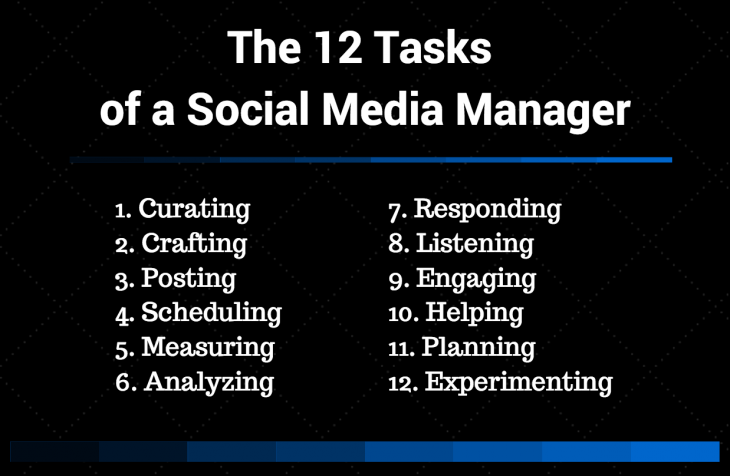
This post originally appeared on the Buffer blog.
You spend part—maybe all—of your day on social media, hopping from network to network, checking analytics, planning ahead, and performing the sundry tasks of a social media manager.
Would it help to know that you’re not alone with keeping such a varied schedule? That your time on social media is shared by others?
I was curious for myself whether my social media manager workload and workflow were similar to someone else’s. Do we perform the same tasks? Do we create similar content? And, perhaps most importantly, do we take the same amount of time to do the same tasks?
Here’s what I found.
Inside a Social Media Manager’s Schedule
Social media tool Socialcast compiled the times and tasks of a typical social media manager schedule and placed them into this interesting infographic. Clearly, social media managers can put in a full day’s work.
Morning:
- Check email
- Reply and retweet
- Post to social media
- Publish a blogpost
- Curate content
- Followup with internal team on ideas
Afternoon:
- Write a blogpost, create content
- Inform team of importance of social media and tools
- Revisit and followup on social media sites and profiles
Evening:
- Review stats for the day
- Sign up for chats, webinars, and events
- Schedule social media messages for overnight and early morning slots
- Check email again
Does this to-do list resemble yours?
Of course, there are many different ways to come at this matter of social media management. Finola Howard shared on LinkedIn about her daily social media habit—a schedule that takes just one hour each day to complete.
Here’s how it works:
- Vet new followers on Twitter using SocialOomph. Follow those who fit; ignore the rest.
- Measure what’s worked. Note your best-performing posts in a spreadsheet or other file so you can reference later as you hone your content.
- Schedule tweets and posts for the day. Finola uses Buffer to keep her queue filled up.
- Find unique content for each channel—Facebook, Twitter, LinkedIn, and Google+.
- Respond and engage. Spend 15 minutes of the first hour here. Consider dipping in for 15 minutes at lunch and at the end of the day, too.
- Monitor engagement levels of fans and followers.
Still another way to go about it is Neil Patel’s streamlined social media strategy. His quick and simple schedule for saving time on social media looks like this:
- Use social media management for posting
- Spend 30 minutes each day on social media scoping, i.e. finding good stuff to share online
- Assign customer service requests to a customer service team
- Check analytics weekly or every other day. Use your social media management tool for analysis.
Ready for still another view on the social media manager time schedule?
Here’s a take from Mark Smiciklas of Intersection Consulting. His infographic takes into account pretty much every element that could ever come into play for a social media manager.
What we learn from these different schedules
These examples of social media manager schedules vary wildly. Some take all day, morning to night. Others take one hour.
How can we reconcile this?
I think we’re looking at two different types of schedules here.
There are social media managers who manage full time.
There are social media users who manage part time.
I’d imagine we’d still find some overlap between the two: full-time social media managers who create blogposts, for instance, or part-time social media managers who do spend a majority of time on social.
In general, though, you likely know where you fall on this spectrum. Is social media marketing a full-time, 40-hours-per-week job for you? Or do you perform social media management in addition to wearing several other hats?
Next page: The 12 tasks of a social media manager
The 12 tasks of a social media manager
1. Curating
Depending on the type of content you share on social, curating can have a huge role in the way you create your updates. Discovering and vetting content from others involves having a deep well of sources to read—as well as the time to read it all.
2. Crafting
Once you’ve found what you want to share, it’s time to figure out how to say it.Crafting a social media update is likely a task that goes faster over time as you gain experience writing headlines, using the most impactful words, and arranging things just the perfect way.
3. Posting
Here’s where a social media management tool really makes a difference. Instead of logging in to a handful of different channels one after another, you can log in to your management tool once and post faster and easier.
4. Scheduling
The next step beyond posting is scheduling: writing your updates ahead of time and queueing them to post throughout the day, overnight, through the weekend, or any other time when you can’t be actively updating your accounts.
5. Measuring
Once your updates go live, you then dig into the metrics surrounding each post. How many clicks did the post receive? What was engagement like? Which stats matter most to you?
6. Analyzing
With the measurement numbers in hand, you can analyze and make your strategy moving forward. For instance, in analyzing the metrics, you might notice that it would be beneficial to change the times that you publish or to focus on a certain type of update. Constant measurement and analysis can reveal these opportunities.
7. Responding
Chances are that people will be responding to your social media updates or reaching out to you directly. At least some portion of a social media manager’s day should be spent responding, however you feel is appropriate—with a reply, a thumbs up, an outreach email, or something else.
8. Listening
In addition to responding to direct contact, you can also keep your ear to the ground via a listening tool or an advanced search that helps bubble up those conversations about you and your brand. It’s amazing how many opportunities are out there that might be missed without proper listening tools in place. For instance, following Twitter mentions for “@buffer” might not turn up all results when folks talk about “Buffer.”
9. Engaging
In addition to replying and responding, there’s also an element of outbound happiness in engaging with your community and other accounts. This can happen via chats or comments, delight campaigns to reach out to others, and by following, friending, liking, and retweeting content from others.
10. Helping
Occasionally, folks might come to you with problems—bugs, breaks, troubleshooting, big questions. These can fall into the realm of the social media manager to handle as best as can be. (Neil Patel’s advice as mentioned above is to send this task along to a customer support team.)
11. Planning
What is the roadmap for future social media marketing? Every so often, the manager needs to zoom out from heads-down work and take a big picture view of things.
12. Experimenting
We’re a bit partial to this one at Buffer. We love experimentation, and this ties into many different tasks already on the social media manager schedule: curating new ideas to try, measuring results, analyzing the numbers, scheduling, crafting, and posting.
The social media manager checklist
Just as there are many different day-to-day schedules of a social media manager, there are also many different checklists, depending on what exactly you have on your plate with your social media management.
Here are four ideas of checklists to get you thinking about what might be included on your daily to-do list.
1. Browse social media for the latest news, trending topics, and conversations
2. Post to Twitter
3. Post to Facebook
4. Post to your LinkedIn profile and company page
5. Post to your personal Google+ profile and communities
6. Post to your Google+ business profile
7. Take pictures of your latest work. Post to Pinterest, Instagram, Facebook, and Tumblr.
8. Engage with your followers and influencers
The Hero X Social Media Checklist
Hootsuite’s 7 Daily Habits of a Social Media Manager
1. Keep your ears open to what users are saying about your brand
2. Stay on top of your metrics – Stay on top of your key social media metrics—reach, engagement metrics, new followers, CTRs to your site, advertising ROI, and the like
3. Watch your back – competition tracking
4. Make new connections
5. Share at least one great ‘happy customer’ story every day
6. Keep up with customer care queries
7. Build your content pipeline
Business 2 Community’s Daily Checklist
- Post At Least Once Per Account
- Like All Comments Left On The Previous Day’s Posts
- Respond To At Least Five Comments Per Day, Per Site
- Connect With At Least One New Person
- Share At Least One Thing Someone Else Has Posted
- Respond To All Valuable Messages You Have Received
Buffer’s approach
I’ve mentioned so far that social media management seems to fit into two distinct types: the full-time job and the part-time job.
Maybe there’s a third way, too?
At Buffer, we’ve found the the job of social media manager to be a team effort. Here’s how things look on the social accounts we manage.
- 1 person for updates
- 1 person for engagement
- A team of people for support, response, and happiness
I fill the queues with content from our blog, content from other sites, and miscellaneous announcements and inspiration.
Nicole posts updates that engage the community with questions, she hosts a weekly Twitter chat, and she is in the comments and replies on a daily basis.
Every member of our customer happiness team spends time on Twitter, answering questions and replying to those who reply to us.
All in all, up to ten Buffer employees will have their hands in social media management any given week.
Finally…
What does it look like to be a social media manager?
Certainly it is one of the best jobs out there. You get to engage with others and share helpful content all day long.
And that’s the other element of the job: It can take all day. Full-time social media managers take on a huge number of tasks, and the time involved can grow exponentially along with the scale of the strategy.
How much time do you spend with social media management?
I’d love to hear what your days look like! Please do share in the comments.
Image credits: Socialcast, Markus Spiske, Hero X, Intersection Consulting
Get the TNW newsletter
Get the most important tech news in your inbox each week.









